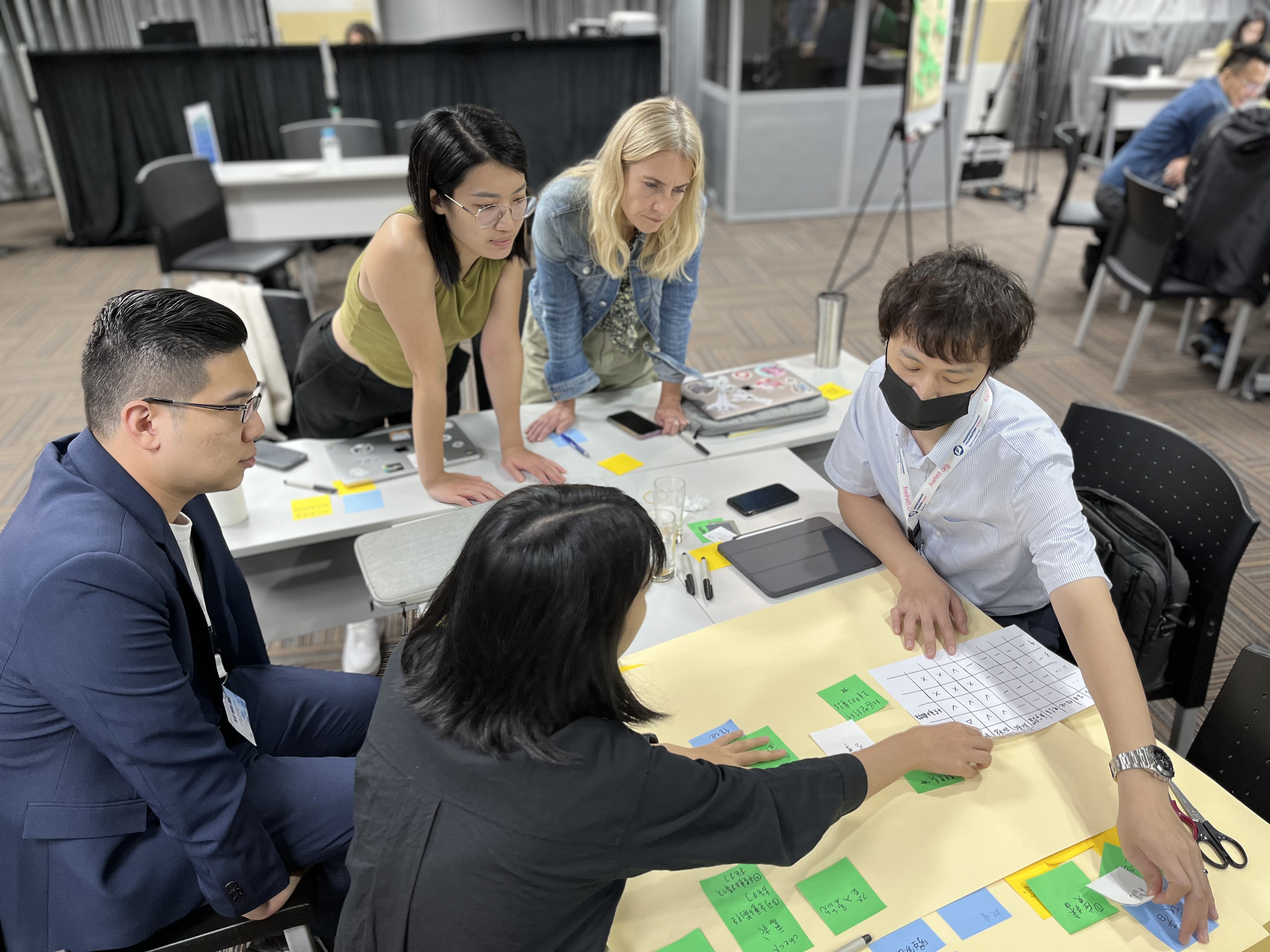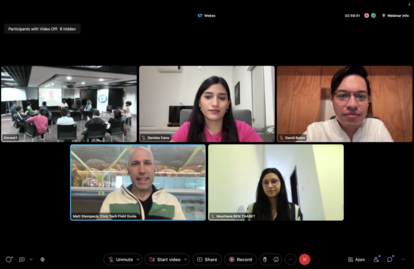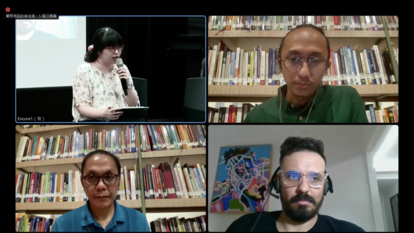Hacking Democracy
Hacking Democracy Conference: How to Enhance Collaboration between People and Government on Public Digital Services

Participants discussed how to design an ideal flu vaccine appointment system for the elderly
© FNF Global Innovation HubWhy do government’s digital services sometimes fail to meet people’s needs? How can they be improved? Where should people start to improve them?
These are the questions that the FNF Global Innovation Hub’s Hacking Democracy Conference aims to answer. To find solutions, the hub incorporated a workshop and a publication releasing event for Examples of Collaboration between Civic Tech Communities and Governments around The World. Through both sessions, participants and speakers contributed various new ideas to “hack” and innovate the existing approach of how governments build up public digital services.
During the workshop, participants engaged in a session with practitioners of successful government-citizen collaboration projects. The Hub invited Mr. Che-Wei Chuang, Technical Specialist at the Forestry and Nature Conservation Agency, Ministry of Agriculture, Taiwan, and Mr. Bo Yang, a senior UI/UX designer and a participant of Rescue Action by Youth .gov 4.0, Taiwan, and Ms. Hao-ting Chang, former design lead of Taiwan’s Public Digital Innovation Space. They shared insights on how to fostering government-citizen collaboration from both governmental and citizen perspectives.
After that, the Hub invited participants to discuss how to work with governments to co-design a user-centric public digital service. Participants were then grouped and tasked with designing a digital system for flu vaccine appointments specifically for the elderly. This exercise helped participants understand how to map all the stakeholders, how to systematically collect their needs, how to develop a strategy encouraging governments’ to collaborate, and how citizen participation can improve the design of public digital devices.
Finally, the Hub officially released the publication by inviting all the authors to present their case studies to the participants. By demonstrating the inspiring examples in the Hub's publication, the Hub aims to challenge the traditional approach of how public digital services are made and demonstrate why citizens’ involvement can innovate and improve public digital services.
The Hub wants to share with you its learning as follows:
What Hinders Government from Collaborating with Citizens

Mr. Che-Wei Chuang, Mr. Bo Yang, and Ms Haoting Chang shared how to encourage governments to collaborate with citizens.
© FNF Global Innovation HubDuring the workshop, participants and speakers talked about the reluctance of governments to involve citizens in developing public digital services. It's crucial to understand the origins of this reluctance in order to effectively address it.
Mr. Chuang explained that the obstacles hindering governments from collaborating with citizens includes budgetary constraints, stringent regulations, and the lack of knowledge. Additionally, resistance from the leadership or mid-level managers at government agencies can be a barrier. He also noted that changes in leadership and ruling party due to elections and political situations can disrupt ongoing collaborations.
Considering the perspective of civil servants, it’s understandable that they may view such participatory approach as creating additional workload, because it may not align with the existing government workplace culture.
In addition, the common approach to establishing digital services may exclude public participation. When there is a need to establish a service, governments tend to put the service out to tender. Governments may invite technology experts or scholars to review all the vendors’ offers and implementation. However, this decision-making process does not necessarily include citizens, who are the users of the service.
Finally. Ms. Chang mentioned a point that is not necessarily negative and even a key to understanding governments’ logic: governments need to stand on everyone’s side. Governments are formed through the votes and consents of the people, and “the people” consist of various stakeholders: citizens, business, religious groups, farmers, and various groups. They have every right as a citizen and have various opinions, and governments still have to take care of each of them, which makes governments hesitate to start their first step to collaborate with the people.
How to Overcome These Challenges and Make a Successful Collaboration
Mr. Chuang replied that to overcome these challenges, it really requires both the enthusiasm of civil servants on the front line and strong support from their supervisors. However, sustaining this enthusiasm and specifying the necessary support remain questions. In the publication, Mr. Matt Stempeck, co-author of the publication and curator of the Civic Tech Field Guide, suggests that governments should reward and recognize civil servants who actively engage in civic tech communities and treat their engagement as an essential task rather than voluntarily extra effort. He also reminded that for citizens strategizing to promote government collaboration, these proactive government employees are key allies.
In the publication, Mr. Stempeck also suggests that different levels of government should develop a culture and sufficient capacities to actively collaborate with citizens. Following that, Ms. Ya-wei Chou, the Hub’s program manager and the moderator of the releasing event, responded that fostering such culture is fundamental and it requires education for government agencies. She emphasized that education should extend to leadership, not just staff, as their attitude and determination play an important role. Furthermore, speakers added that since digital services usually involve multiple government agencies, it is important to educate leadership across all the agencies the importance on user-centric design and people’s participation.
During the publication releasing session, Mr. David Bates and Ms. Daniela Ramirez, the authors of the Mexico case of FNF’s publication, proposed ideas to engage governments in collaboration by actively creating connections with civic tech communities or related projects. Mr. Bates suggested fostering connections by inviting government staff to civic tech gatherings, while Ms. Ramirez emphasized proactive creation of collaboration opportunities through joint projects. Also, Ms. Nourhane Ben Thabet, President of the Tunisian e-Governance Society and the author of the case of Tunisia in FNF’s publication, underscored the significance of encouraging young civic tech enthusiasts to interact with government figures, drawing from her own experiences.
With the understanding that governments need to stand on everyone’s side, Ms. Chang shared that setting a realistic goal for a project is crucial to keep the dialogue and opportunities for collaboration alive. She advised that initial discussions should focus on finding acceptable solutions rather than striving for perfection that satisfies everyone. This can leave sufficient space and flexibility to encourage governments, citizens, and stakeholders to listen to each other and work together to form a consensus.
Following Ms. Chang, Mr. Yang emphasized that alignment is vital not just for setting expectations, but also for defining goals, communication, and understanding each other’s work styles. When a government and its citizens start a collaboration, it becomes like a team. To help this team to achieve the best result, each member has to repeatedly confirm whether she/he/they really understands what their team members say, whether everyone’s perception of the goal is the same, and whether everyone knows each other’s work style well and thereby figure out how to best collaborate. Constant alignment at every project stage will foster trust in the team and the confidence in achieving the project’s goal.
Then, how to achieve alignment? Mr. Yang also shared that visualizing framework of discussions, progress of the project, road map of implementation, and most of the necessary information of the collaborative project ensures that everyone acquires the same amount of information. Secondly, when communicating with your team mates, repeating the last few words of their sentences, imitating their tones, and paraphrasing their words and asking them to confirm or inviting them to share more are useful tips.
In the second half of the Hacking Democracy Conference, FNF invited the authors of the publication Examples of Collaboration Between Civic Tech Communities and Governments Around the World to virtually launch this publication together.
Cases of America, Mexico, Tunisia, and Taiwan

Mr. Matt Stempeck, Mr. David Bates, Ms. Daniela Ramirez, and Ms. Nourhane Ben Thabet presented their case studies.
© FNF Global Innovation HubMr. Stempeck introduced the case of the U.S. by highlighting BetaNYC as an notable example. It is an organization that partners extensively with various levels of the New York City government. BetaNYC promotes open government legislation and empowers citizen involvement through community boards, enabling public participation in resolving local issues.
As for the case of Mexico, Mr. Bates and Ms. Ramirez introduced Visor Urbano, a digital solution transforming land use management. They shared how Visor Urbano effectively addresses bureaucracy and political corruption in real estate. By digitizing and simplifying procedures and thereby improving transparency, Visor Urbano effectively integrates public needs into policy-making. They highlighted that the involvement of civic tech communities and citizens and ensuring accessibility are the key to make Visor Urbano a successful public digital service. Also, they stressed the need for more civic technologies to facilitate participation in decision-making.
Ms. Ben Thabet shared the Collaborative Digital Geospatial project which addresses the need to improve urban development in smaller Tunisian cities. Citizens and civil servants collaborated to gather local map data for the project by biking around their cities, which innovated and incentivized the citizens to participate in the project. Ms. Ben Thabet also stressed that to facilitate such collaboration, governments should actively advocate for public participation in proposing ideas and projects aiming to make the whole society, cities, or a country a better place.
Through a video presentation, Dr. Mei-chun Lee showcased various civic tech-government collaborations in Taiwan, including projects for pandemic prevention, disaster management, environmental protection, and enhancing people’s participation in law-making. She pointed out that due to the volunteer-driven nature of these projects, the challenge is how to sustain these programs after incidents such as an outbreak of a pandemic or disasters. Therefore, she emphasized the importance of integrating these initiatives into existing bureaucratic structures. Finally, she stressed that it is crucial to keep nurturing Taiwan's democracy, because that’s the key to inspire and guide Taiwan’s civic tech community members and citizens to apply technology for enhancing democracy and good governance.
Cases of Germany, Indonesia, and Morocco

Mr. Kes Tuturoong, Mr. Wana Alamsyah, and Mr. Oussama Abdelah Benhmida presented their case studies.
© FNF Global Innovation HubDelivering her presentation via video, Dr. Henriette Litta from Open Knowledge Foundation discussed civic tech development in Germany. Though civic tech in Germany has boasted a vibrant scene for a long time, successful collaboration between civic tech communities and the government remains limited due to bureaucratic complexities. She also emphasized the necessity for sustainable solutions over short-lived digital products. On the other hand, she mentioned the inspiring action of #WirVsVirus Hackathon in 2020 and said that Germany's digital civil society strives for continuous improvement and long-term engagements.
Representing Indonesia Corruption Watch (ICW), Mr. Kes Tuturoong and Mr. Wana Alamsyah shared with us the case of Opentender.net, a website co-created by ICW, civic tech communities, and the National Public Procurement Agency in Indonesia. The website allows the public to monitor public procurement contracts. Mr. Alamsyah highlighted the importance of building trust for effective partnerships since the biggest challenge lies in the citizens’ fear or insecurity of taking action to monitor public procurements, as some have encountered attacks before when reporting wrongdoings to law enforcement. He also mentioned that people should also take technology accessibility issues into consideration when initiating any project. Mr. Tuturoong added that the sustainability of projects or solutions developed in civic tech Hackathons remains a problem to be tackled.
Mr. Oussama Abdelah Benhmida, a civic tech and digital transformation expert and the author of the case of Morocco in FNF’s Publication, introduced the Woussoul, a project aimed at aiding individuals with physical disabilities in navigating urban spaces. Collaborating with the Moroccan Ministry of Family Affairs, local authorities, citizens, and architects, they gathered data for the Woussoul app from public facilities and private businesses. Mr. Benhmida stressed that involving all the possible stakeholders in projects is essential to ensure credibility of projects and attract more people with diverse expertise to contribute to the project.
If you would like to dive into the aforementioned cases in these countries, read our publication by downloading it from: https://www.freiheit.org/publikation/examples-civic-tech-communities-governments-collaboration-around-world
*Edited by Ms. Judy Peng, Communications Officer / Drafted by Ms. Ko-Hsuan Lu, Admin Assistant, and Ms. Rebecca Kuo, Project Assistant of FNF Global Innovation Hub
